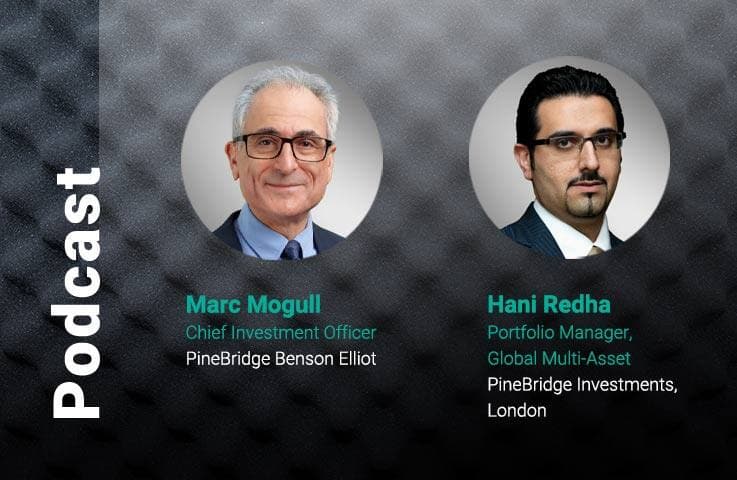Capital Market Line: Deglobalization Marches On

Michael J. Kelly, CFA
Global Head of Multi-Asset

Hani Redha, CAIA
Portfolio Manager, Head of Strategy and Research for Global Multi-Asset

Steven Lin, CFA
Portfolio Manager, Global Multi-Asset

Peter Hu, CFA, FRM
Portfolio Manager, Global Multi-Asset

Sunny Ng, CFA
Portfolio Manager, Global Multi-Asset

Mikhail Johaadien
Research Analyst, Global Multi-Asset

Teresa Wang
Vice President, Research Analyst, Global Multi-Asset

The rise in globalization following World War II was guided by a handful of key principles, among them the lowering of market barriers such as tariffs and subsidies, both viewed as market-distorting. In 1978 through 1980, Deng Xiaoping, Margaret Thatcher, and Ronald Reagan reorientated their economies toward freer markets, with Deng’s China allowing the market to play a more decisive role. The fall of the Berlin Wall in 1989 witnessed former Cold War adversaries boosting their trade with each other. For the first time, country-level champions could attempt to become true global champions, with technology transfer and the onset of global supply chains helping to spur stepped-up productivity and growth without inflation.
Yet instead of the reserve currency rebalancing ever-larger trade flows, the US dollar was on a one-way street: rising higher despite a secularly rising trade deficit. This reflected non-USD countries’ need to carry an ever greater quantity of dollars to facilitate their stepped-up trade.
As an initial measure to address the trade pressures from an ever stronger US dollar, Trump 1.0 pursued tariffs on China, which represented the US’s largest bilateral trade deficit. During President Xi Jinping’s second term, China stopped letting the markets play a more decisive role, pivoting once again away from freer markets toward more centralized control. This included a redirection toward state-directed investment, including rebooted subsidies for select export industries, along with steering the flow of funds toward a resurgent military. Following this was the Biden administration’s “small yard, tall fence” policy of restricting exports of high-tech products with military consequence to China. China then re-instituted its long-dormant “inseparable partnership,” yet this time with Russia (albeit with Russia pursuing the former Soviet Union footprint).
With military and philosophical walls forming again, the direction of travel continues to move away from freer markets. Into this backdrop the US administration has begun acting unilaterally to offset pressures on US tradable goods that come with being the reserve currency, as well as taking measures to spread the load from an escalating defense burden. These steps have medium-term implications for markets and alliances.
Focusing on the major economies, relative to production, the US over-consumes while Europe and China under-consume, with secularly trending imbalances that will last as long as the overproducers are willing to take on more of the over-consumer’s sovereign debt and implicitly its reserve currency, and if the over-consumer is willing and able to sustain a growing debt burden. With or without Trump 2.0, the US dollar will be the arbiter on when unsustainability is reached and rebalancing must begin. The US fiscal balance is now running, during healthy times, in the 6.5%-7.0% range, previously a stressed level only hit only during recessions. Today’s high starting point is owing to post-Covid spending programs (the CARES Acts 1 and 2, the Infrastructure Act, the Inflation Reduction Act, and the CHIPS Act) combined with demographically driven acceleration of entitlement spending from here. For these reasons alone, while not anticipated, it’s not out of context that the US dollar is decoupling from prior relative interest rate relationships. Such decoupling suggests a growing risk premium on US assets, which speaks to the unsustainability of existing trends, and thus the likelihood that we are at a meaningful turning point.
The question is whether there will be breakage or a “beautiful rebalancing.” We suspect some of each. While the US may well achieve Agreements in Principle (AIP) to rebalance trade via tariffs with Japan, India, South Korea, Taiwan, Mexico, and Canada, progress will either slow or stop there. The eurozone is unlikely to meaningfully ally with China on trade, given that both economies are wired to generate trade surpluses, which will increasingly compete for a bigger share of a smaller global trade pie. We have already witnessed countries as far flung as Indonesia and Brazil placing tariffs on China too. Europe is thus more likely to pursue a strategy of generating higher domestic demand and strengthening trade ties with the rest of the world. This leaves potential for a partial cooperation with the US to rebalance trade between the two parties. European companies and European-domiciled US subsidiaries of US companies are likely to see scope to re-shore some production into North America as well. After downplaying years of US requests for fairer burden-sharing on defense and security, US threats of substantial tariffs and assertive foreign policy have compelled Europe to reassess its defense.
The European Commission has relaxed fiscal rules, exempting defense expenditures of up to 1.5% of GDP from budget constraints. Germany is leading this transformation, with plans to ease fiscal policy significantly, including substantial exemptions for defense spending from constitutional debt limits and establishing a €500 billion fund for infrastructure and climate investments. This marks a decisive break from Germany’s post-global financial crisis austerity measures and could boost Germany’s GDP growth by 1%-2% from 2026 onward. The spillover effects across Europe might add an additional 20 to 30 basis points of growth in the eurozone, potentially marking the end of the continent’s prolonged stagnation.
Yet this form of “brute force” deficit-driven growth is fairly low-quality in nature, and unlikely to raise medium-term potential in the absence of reforms that reduce over-regulation. The Competitiveness Compass is Europe’s attempt to implement the Draghi recommendations – we lean skeptical about Europe’s ability to achieve these reforms, yet are open-minded about the impetus created by the emerging new world order in both trade and military matters.
How will China respond, and how will smaller countries caught in the crosshairs react? China has been diversifying its export markets since the first Trump administration and has made progress over the past six years – though less than generally acknowledged, since meaningful new exports to Global South countries merely end up being rerouted to the US or are finished and go to the US as Vietnamese or Mexican products. Directly and indirectly, the US remains significant and difficult to replace as a trading partner to China. A good portion of Chinese imports into the US are likewise hard to replace.
Given this, we do expect an eventual détente between China and the Trump administration that alleviates what is now effectively an embargo between the two, yet the direction of travel remains toward more decoupling. Countries such as Vietnam are caught in between. Others, such as India may actually benefit by walking the tightrope while attracting foreign direct investment as a replacement for China. For example, Apple may move its entire iPhone supply chain to India. The world, however, will likely end up less efficient, suffering from the unproductive duplications inherent to protectionism. However, the Trump administration sees this as a “less bad” and more sustainable choice than importing market distortions from an increasingly non-market and sizeable economy aligning militarily with Russia. Also, dominant nations fail from overextending themselves, and the US is facing an ever-larger trade burden from the impact of the reserve currency on tradeable goods, and a rising financial burden from an overextended defense umbrella that now needs to compete with a reunified China/Russia militarily. Of course, the primary financial burden the US faces is secularly rising entitlements from an aging society; nonetheless, one way or another it must inflect downward its secularly rising fiscal deficits.
Meanwhile, China is stepping up stimulus to counteract external tariff pressures and lowered receptivity to its overproduction. AI development is ramping up, highlighted by DeepSeek’s recent release of its open-source R1 large language model. This breakthrough has significantly boosted AI activity among major Chinese tech companies. The top five tech firms in China are set to double their capital expenditures on AI compared to last year, reaching approximately RMB400 billion. The government has already injected 1.1% of GDP to target and further support technology sectors such as AI and autonomous driving. They may also front-load infrastructure and consumer subsidies worth 2%-3% of GDP.
Despite concerns that DeepSeek’s cost-efficient AI model training could reduce the overall need for investment, we see this more as a shift in mix rather than magnitude. AI spending remains a potential business model maker or breaker and will continue to be prioritized. However, DeepSeek marks the beginning of a gradual shift from training to inference. This points to sustained demand for capex while the race to become the dominant AI super app plays out. AI’s transformative potential is still far from fully realized. Its most impactful applications – such as real-time data analytics, large-scale automation, and humanoid robotics – require time to mature and integrate across industries. That integration is further slowed by evolving regulatory frameworks and adoption challenges. DeepSeek is driving down costs, which should support broader use of AI technologies. We remain confident that this secular trend will reshape economies and drive long-term productivity growth.
In the US, the most important shift is an attempt to rein in the budget deficit and regulatory over-reach to give the private sector more scope for productive growth. Yet reducing the deficit will be challenging given the trajectory of entitlement programs and rising geopolitical tensions, which are nudging up already-high defense expenditures. Over the medium term, the hope is that lower tax rates and higher productivity can raise more tax revenue through growth, with some efficiency gains in spending. Given the stagflationary impulse we expect to result from trade policy, it will be tough to grow out of the deficit. Much will depend on increased vibrancy of the private sector through AI and productivity, and the extent to which this can push growth higher. We think it can, and will – the questions is whether it will be enough, given the challenges.
What are the implications for monetary policy? Taking a step back, we note that the unprecedented fiscal stimulus of the past few years needed to be met with tight monetary policy to combat higher inflation. Now, the pendulum is swinging in the opposite direction. Beyond the initial stagflationary impulse from trade policy, we expect the Federal Reserve to resume its easing cycle. At the same time, we expect the neutral rate to drift slightly higher given the pull from reshoring and vying for AI retooling. A rising real rate, of course, shrinks the distance to the new neutral rate.
A key issue looming over financial markets is the loss of confidence in US assets that has resulted from the Trump administration’s unilateral, erratic, and self-serving policies. Anecdotal evidence suggests that capital flows are rebalancing away from the US – a “sell America” trade. Will this continue, and what would be the implications for the US dollar? We see scope for this rebalancing to persist in the form of an unwinding of the unprecedented concentration in US assets that had built up over the past few years, when “US exceptionalism” was the only game in town. Then in 2025, Europeans had reason to reallocate back to Europe given their new fiscal thrust, DeepSeek provided a new avenue for China to revive, and the US inflicted upon itself both a slowdown, driven by surprising job cuts to its federal workforce, and a tariff-driven stagflationary threat, which was also unilaterally imposed on others.
Notwithstanding near-term potential for these reallocations away from the US to ease as Trump now de-escalates, the sheer size of this asset base (measured in trillions) is likely to put downward pressure on the US dollar over the medium term. Is the US dollar losing its global reserve currency status? In our view, this is a tail risk, rather than the base case. Yet can this global rebalancing of trade and capital flows from an extreme starting point lead to an erosion of the dollar’s current status? Yes, we now see that as the likely outcome of these tectonic shifts, despite currently wide interest rate differentials.
The global economy appears to be at a turning point, attempting a global rebalancing along multiple dimensions for various reasons. Therefore, the potential for outsized returns, and risks, is also present. Our Capital Market Line process has proven to be a valuable anchor over more than two decades, designed with precisely these regime shifts in mind, and is pointing to important portfolio implications and investment opportunities ahead.
Capital Market Line as of 31 March 2025 (Local Currency)

Capital Market Line as of 31 March 2025 (USD View, Unhedged)

Please see Capital Market Line Endnotes. Note that the CML’s shape and positioning were determined based on the larger categories and do not reflect the subset categories of select asset classes, which are shown relative to other asset classes only.
Insights From Today’s CML
Our Capital Market Line (CML) is steepening after a long flat period, with continued high dispersion. This shift is driven by ongoing geopolitical, policy, and technological changes, which are currently more influential than in most historical periods. The period ahead will also see attempts to modify or reverse unsustainable trends that had built up over decades. We expect some changes that will have significant impacts on cash flows, potentially widening global growth gaps, though with considerable uncertainty. These same forces are creating both opportunities and risks, contributing to the high dispersion. We do not rely on long-term mean reversion. Instead, our strategy focuses on leveraging growth driven by enduring technological and geopolitical shifts over the medium term (defined as five years). We anticipate an era of change that will stimulate investment, likely exerting upward pressure on real rates.
Focus on equities with strong resilience amid rising tariff risks. In a higher nominal world, equities are a well-positioned asset class, powered by nominal cash flows. Tariffs are a potential challenge for profit margins, and therefore quality companies will persistently outperform due to the resilience of their moats and margins. The rollout of AI in both the US and China presents attractive opportunities over the medium term, driving productivity growth beyond the tech sector. European industrials and defense stocks have rallied yet remain attractive, given the German fiscal programs rolling out over the next few years. US reshoring is already underway and is likely to accelerate as tariffs change the capex calculus in favor of US industrials. These targeted exposures complement broader geographic allocations and position portfolios to navigate a more fragmented, de-globalizing world.
Shifting the balance from US Treasuries to include UK gilts and German bunds. Following the Fed’s rate-cutting cycle, medium to long-term US Treasury yields rose, spiking again after the US election and amid tariff-related growth fears. We have been leaning away from US Treasuries toward UK gilts; the Bank of England will likely need to cut rates further than the market expects, given the UK’s very limited scope to expand fiscal deficits. Germany’s proposed spending is poised to boost growth, likely steepening the yield curve, yet unlike in the US, the starting point is subdued inflation.
Credit spreads are tight, but opportunities exist. In the current “Balanced Growth” regime, the correlation between stocks and risk-free bonds is around zero, unlike the -0.4 correlation during the “Stall Speed” regime. This change diminishes the appeal of risk-free fixed income relative to growth assets at any point on the rates curve. Credit spreads remain tight across most markets, supported by the strong growth environment. However, there are notable opportunities in Asia’s high yield bond market (excluding China’s property sector) and, to a lesser extent, in US mortgage-backed securities (MBS), where spreads are typical in an otherwise tight market. Additionally, further rate cuts could enhance banks’ ability to retain deposits, potentially easing some technical constraints on MBS. Investors should be on the lookout for overreactions to near-term recession risks in US high yield spreads, which can present attractive entry points to add credit risk to portfolios.
Gold, a hedge for geopolitical and USD-debasement risks. Gold continues to perform well as a hedge for geopolitical risk. While a prolonged ceasefire in the Russia-Ukraine conflict might temporarily lower gold prices, a comprehensive peace agreement, which would likely require significant sanction relief for Russia, seems less probable than an extended ceasefire without a formal deal. Meanwhile, the trend of de-dollarization among Global South central banks is expected to persist, supporting gold prices. Since the global financial crisis, gold has been in a long bull market, driven by Western central banks’ quantitative easing policies, which caused global M2 money supply growth to outpace global GDP growth. Currently, even as the Fed and the ECB reduce their balance sheets, the People’s Bank of China is surging its own, offsetting the Western contractions. If the PBOC continues to increase its balance sheet to address its creeping balance sheet recession, China’s M2 growth alone could reignite the expansion of global M2 relative to global nominal GDP, likely boosting gold’s rise. Any loss of confidence in the US dollar will be supportive of other G7 safe-havens, such as the Swiss franc, yet gold will also be a beneficiary.
The Fundamentals Driving Our CML
Tariff and geopolitical risks lead to shifts in supply chains. Higher tariffs are accelerating the process of deglobalization, driving reshoring efforts. In a world moving toward deglobalization, securing supply chains becomes costlier, driving medium-term inflation pressures and stimulating investment. Those trends are being driven by strategic and geopolitical considerations, becoming another driver for investing in increased productivity.
Transitioning to a “Balanced Policy” regime. Following the global financial crisis, Western economies faced mild balance sheet recessions marked by sluggish consumption and investment as the private sector deleveraged. The clash between reduced investment and a strong inclination to save, which typically drives rates down, was intensified by monetary policies like quantitative easing and negative interest rates. Fiscal policy was relatively passive, placing the burden on monetary authorities. This “old abnormal” era persisted until around 2015, when our CML cash flow growth projections reflected less growth and more lenient capitalization rates than anticipated. Since then, growth has accelerated, supported by healthier household and corporate balance sheets and secular changes. Post-Covid, fiscal policy has shifted from passive to activist, but we view this as a low-quality and unsustainable form of “US exceptionalism.” The Trump 2.0 administration aims to shift US growth drivers such that heavy government spending has a reduced role, encouraging the private sector to fill the gap. This transition removes a key source of economic support, which is painful for growth but seen as necessary medicine for long-term sustainability.
AI as a catalyst for productivity. Technological advancements and enhanced human capital investments are reshaping labor, business models, and national security. Tools like generative AI are set to automate a significant portion of tasks across various jobs, improving labor efficiency, creating new job opportunities, and boosting overall productivity. This transformation not only increases US labor productivity but also drives innovation and efficiency across multiple sectors, positioning AI as a key driver of future economic growth and supply-led expansion. China is also ramping up its AI development efforts. With DeepSeek driving down costs, the transition toward application deployment and monetization is likely to accelerate, supporting faster integration and broader use of AI technologies. This secular trend will reshape economies and drive long-term productivity growth.
A test for US assets. A key issue that looms over financial markets is the loss of confidence in US assets that has emerged following the Trump administration’s extreme and mercurial policies. We see scope for a rebalancing away from US assets, reflected in an unwinding of the unprecedented concentration in US assets that had built up over the past few years. The combination of weaker US growth (due to tariffs and fiscal cutbacks) with fiscal thrusts in Europe and China can encourage this unwinding. Notwithstanding near-term potential for these flows to ease as Trump de-escalates, the sheer size of this asset base (measured in trillions) is likely to put downward pressure on the US dollar over the medium term. We believe the potential for the US dollar to lose its reserve currency status remains a tail risk rather than the base case. Yet the global rebalancing of trade and capital flows from an extreme starting point could very well lead to an erosion of the dollar’s current overvaluation.
Capital Market Line Endnotes
The Capital Market Line (CML) is based on PineBridge Investments’ estimates of forward-looking five-year returns and standard deviation. It is not intended to represent the return prospects of any PineBridge products, only the attractiveness of asset class indexes, compared across the capital markets. The CML quantifies several key fundamental judgments made by the Global Multi-Asset Team for each asset class, which, when combined with current pricing, results in our annualized return forecasts for each class over the next five years. The expected return for each asset class, together with our view of the risk for each asset class as defined by volatility, forms our CML. Certain statements contained herein may constitute “projections,” “forecasts,” and other “forward-looking statements” which do not reflect actual results and are based primarily upon applying a set of assumptions to certain financial information. Any opinions, projections, forecasts, and forward-looking statements presented herein are valid only as of the date of this document and are subject to change. There can be no assurance that the expected returns will be achieved over any particular time horizon. Any views represent the opinion of the investment manager and are subject to change. For illustrative purposes only. We are not soliciting or recommending any action based on this material.
About the Capital Market Line
The Capital Market Line (CML) is a tool developed and maintained by the Global Multi-Asset Team. It has served as the team’s key decision support tool in the management of our multi-asset products. In recent years, it has also been introduced to provide a common language for discussion across asset classes as part of our Investment Strategy Insights meeting. It is not intended to represent the return prospects of any PineBridge products, only the attractiveness of asset class indexes compared across the capital markets.
The CML quantifies several key fundamental judgments made by the Global Multi-Asset Team after dialogue with the specialists across the asset classes. We believe that top-down judgments regarding the fundamentals will be the largest determinants of returns over time driving the CML construction. While top-down judgments are the responsibility of the Multi-Asset Team, these judgments are influenced by the interactions and debates with our bottom-up asset class specialists, thus benefiting from PineBridge’s multi-asset class, multi-geographic platform. The models themselves are intentionally simple to focus attention and facilitate a transparent and inclusive debate on the key drivers for each asset class. These discussions result in 19 interviews focused on determining five year forecasts for over 100 fundamental metrics. When modelled and combined with current pricing, this results in our annualized expected return forecast for each asset class over the next five years. The expected return for each asset class, together with our view of forward-looking risk for each asset class as defined by volatility, forms our CML.
The slope of the CML indicates the risk/return profile of the capital markets based on how the five-year view is currently priced. In most instances, the CML slopes upward and to the right, indicating a positive expected relationship between return and risk. However, our CML has, at times, become inverted (as it did in 2007), sloping downward from the upper left to the lower right, indicating risk-seeking capital markets that were not adequately compensating investors for risk. We believe that the asset classes that lie near the line are close to fair value. Asset classes well above the line are deemed attractive (over an intermediate-term perspective) and those well below the line are deemed unattractive.
We have been utilizing this approach for over a decade and have learned that, if our judgments are reasonably accurate, asset classes will converge most of the way toward fair value in much sooner than five years. Usually, most of this convergence happens over one to three years. This matches up well with our preferred intermediate-term perspective in making multi-asset decisions.
Disclosure
Investing involves risk, including possible loss of principal. The information presented herein is for illustrative purposes only and should not be considered reflective of any particular security, strategy, or investment product. It represents a general assessment of the markets at a specific time and is not a guarantee of future performance results or market movement. This material does not constitute investment, financial, legal, tax, or other advice; investment research or a product of any research department; an offer to sell, or the solicitation of an offer to purchase any security or interest in a fund; or a recommendation for any investment product or strategy. PineBridge Investments is not soliciting or recommending any action based on information in this document. Any opinions, projections, or forward-looking statements expressed herein are solely those of the author, may differ from the views or opinions expressed by other areas of PineBridge Investments, and are only for general informational purposes as of the date indicated. Views may be based on third-party data that has not been independently verified. PineBridge Investments does not approve of or endorse any republication of this material. You are solely responsible for deciding whether any investment product or strategy is appropriate for you based upon your investment goals, financial situation and tolerance for risk.



